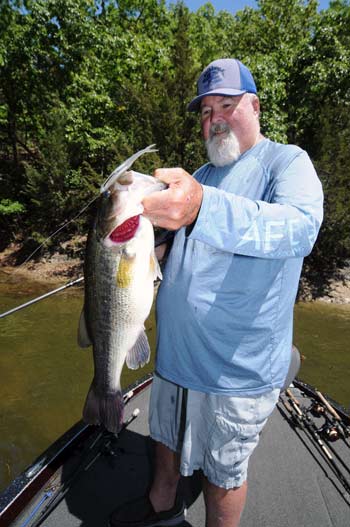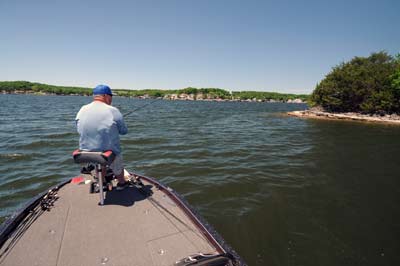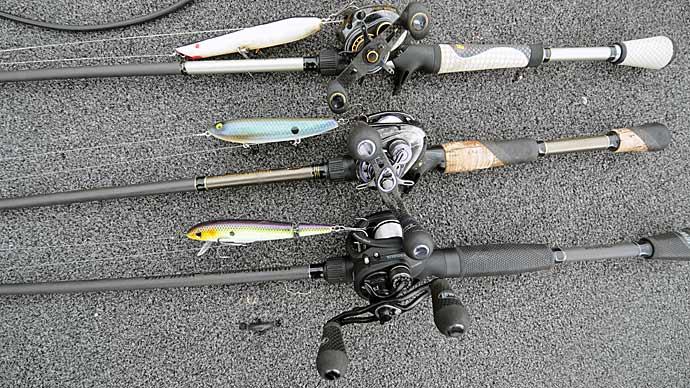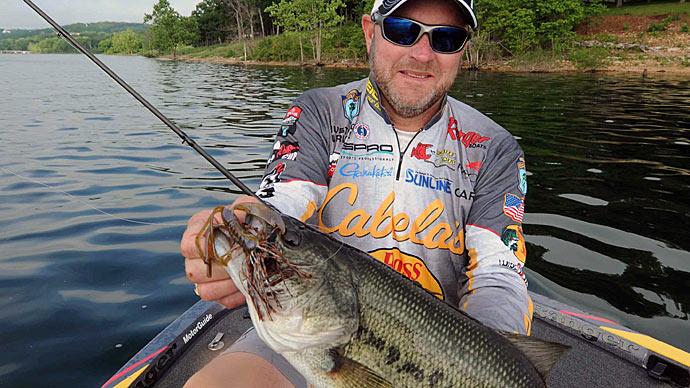
History is on your side when fishing your home waters for postspawn bass.
From years of experience on your home waters, you know where to start searching for bass after the spawn and what patterns should produce. However, you face new challenges during a vacation fishing trip or tournament in an unfamiliar fishery. Then you have to learn the new waters' features (water clarity, structure, cover, forage, etc.) and put together a game plan for catching postspawn bass.
Former Bassmaster Classic and FLW Cup champion Dion Hibdon has faced the challenge of finding and catching postspawn bass on unfamiliar waters throughout the country during his distinguished pro career. He suggests keying off forage to find bass on any body of water you encounter. "You just kind of have to know what the (bass) forage is and where the forage will be," Hibdon says. "The basic deal for any body of water is that you will have a little lull of about a week when you will not catch many of those (postspawn) females. But when they finally get settled in where some food is, they will put on a feed bag and start eating."
The Missouri Pro offers the following insight into how and where to catch postspawn bass on six types of bass fisheries spread throughout the country.
Highland Reservoirs
Examples: Table Rock and Bull Shoals lakes.
Bass species: Largemouth, smallmouth, and spotted bass.
Primary forage: Gizzard and threadfin shad, minnows, and crayfish.
Water clarity: Clear to gin clear.
Standard features: Rocky and deep.
Typical structure and cover: Points, islands, standing timber, laydown logs, rocks.
Best postspawn lures and tactics: Hibdon notes a shad spawn usually occurs when bass are in the postspawn stage, so bass pull out to the rocky points where the wind and current congregate shad in certain areas of the points. He suggests islands can be key structures for finding postspawn bass chowing on baitfish. "An island just means there are two points close together, so no matter which way the wind is blowing, bass don't have to swim very far to where the wind is channeling the shad to them.” Any shad-imitating lures, such as crankbaits, topwater baits, and swimbaits, trick postspawn bass on highland reservoirs. Hibdon also likes to throw a creature bait on a wobblehead jig to catch bottom-hugging bass.
Lowland Reservoirs

Examples: Sam Rayburn, Toledo Bend, and Kentucky lakes.
Bass species: Largemouth bass and some smallmouth and spotted bass.
Primary forage: Gizzard and threadfin shad, minnows, and crayfish.
Water clarity: Stained to murky.
Standard features: Mud bottom and shallow.
Typical structure and cover: Long flat points, flats, shallow bays, shell beds, roadbeds, and aquatic vegetation such as milfoil and hydrilla.
Lures and tactics: Hibdon suggests searching for postspawn bass along hard bottom spots such as road beds and shell beds or along the edges of grass where the shad spawn. Top lures for lowland reservoir postspawn bass include spinnerbaits and squarebill crankbaits.
Northern Natural Lakes
Examples: St. Clair, Champlain, and Erie.
Bass species: Smallmouth and largemouth.
Primary forage: Gobies, yellow perch, and bluegill.
Water clarity: Clear.
Standard features: Bowl-shaped and flat bottom mixed with rock and sand.
Typical structure and cover: Rock piles, sand bars, and aquatic vegetation. “Natural lakes are normally pretty weedy with lots of reeds and grass, which is where a bass’ food is going to hang out,” Hibdon says.
Lures and tactics: “Those yellow perch are roamers and can be right out in the middle of the lake,” Hibdon says. “So postspawn is slightly different in those lakes just because sometimes the food gets way offshore.” The Missouri pro notices gobies tend to prefer rocky areas, so he advises finding hard spots with your depth finder to locate the forage and bass. His favorite lures for postspawn smallmouth are topwater walking lures and Flukes. Postspawn largemouth tend to hang closer to the weeds, so Hibdon suggests throwing topwater frogs and plugs, as well as Senkos. Jigs and creature baits attached to wobblehead jigs are also productive lures for both smallmouth and largemouth.
Florida Lakes
Examples: Okeechobee and Tohopekaliga (Toho).
Bass species: Florida-strain largemouth. Hibdon warns that Florida-strain largemouth are moody fish, especially in cold front situations. "They are terrible about cold fronts," he says. “They don’t handle that situation well. It could shut them right off.” The tournament veteran suggests it is preferable to fish for Florida largemouth during a pattern of steady good weather, no matter what time of year you go there.
Primary forage: Shad and shiners.
Water clarity: Tannic colored except clear in grassy areas.
Standard features: Shallow and a soft bottom of sand and mud.
Typical structure and cover: Points at canal mouths, riprap on rim canals, Kissimmee grass, and reeds.
Lures and tactics: "The crazy thing about those Florida lakes is you can catch postspawn bass in January," Hibdon says. "The bass there spawn every full moon from December through May. So most of the time, you have postspawn, prespawn, and spawn all going on simultaneously." He suggests finding boat alleys running through the grass where postspawn bass will move out to the main lake. Shad will be spawning in the grass, so Hibdon advises targeting solid lines of matted grass to catch postspawn bass. The best lures include spinnerbaits, topwater baits, lipless crankbaits, and swimbaits.
Tidal waters
Examples: Potomac and James rivers.
Bass species: Largemouth.
Primary forage: Shad, minnows, and crabs.
Water clarity: Stained to murky except in grass areas.
Standard features: Shallow with mostly soft bottom of mud and sand.
Typical structure and cover: Feeder creeks, stumps, laydown logs, milfoil, eelgrass, and reeds.
Lures and tactics: “The (bass) food acts slightly different there than anywhere else,” Hibdon says. “The food reacts to the current every eight hours. The current comes in, and the water gets high. Then, it turns around and goes right back out. So the food sets up in different places because of that current situation." He notices that shad will congregate behind a patch of grass or other current breaks to avoid the strong water flow.
Hibdon considers the low outgoing tide the best time to catch tidal bass. “It uncovers everything where the fish live and collects everything in little places, whereas when the tide is up, there is a lot of stuff to fish around. Bass can then swim anywhere they want." Lures he recommends for postspawn tidal bass include jigs for imitating fiddler crabs or shad imitators such as lipless crankbaits, squarebill crankbaits, and Chatterbaits.
Inland rivers
Examples: Mississippi, Arkansas, and Red Rivers.
Bass species: Largemouth, smallmouth, and spotted bass.
Primary forage: Shad, minnows, and crayfish.
Water clarity: Murky to muddy.
Standard features: Shallow with a silt bottom of sand and mud.
Typical structure and cover: Feeder creeks, sloughs, islands, laydown logs, and rock jetties.
Lures and tactics: "(Inland rivers) are like fishing the tide, but the current only goes one way," Hibdon says. Hibdon targets eddies, current breaks, mouths of sloughs, and rock jetties for postspawn bass when fishing the main channel. “Those jetties will have a sweet spot somewhere on it where a lot of times there is a tiny hole, and the water is rushing through it. That’s a good spot.” He suggests that even a single rock breaking the current along the bank can be a magnet for baitfish and bass. Great baits for catching postspawn bass in the rivers are Chatterbaits, squarebill crankbaits, lipless crankbaits, and swimbaits.




